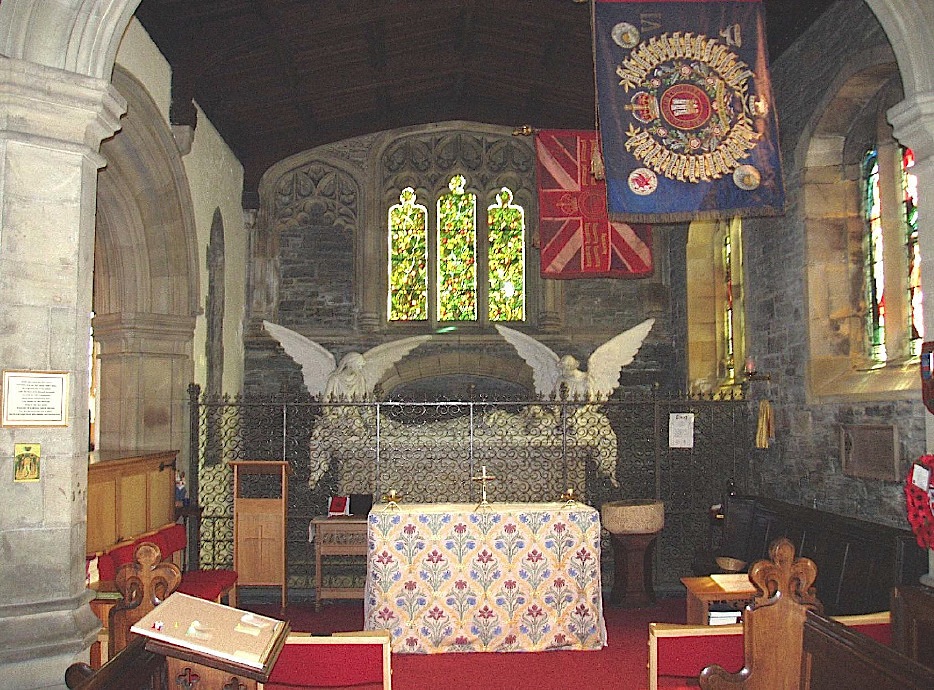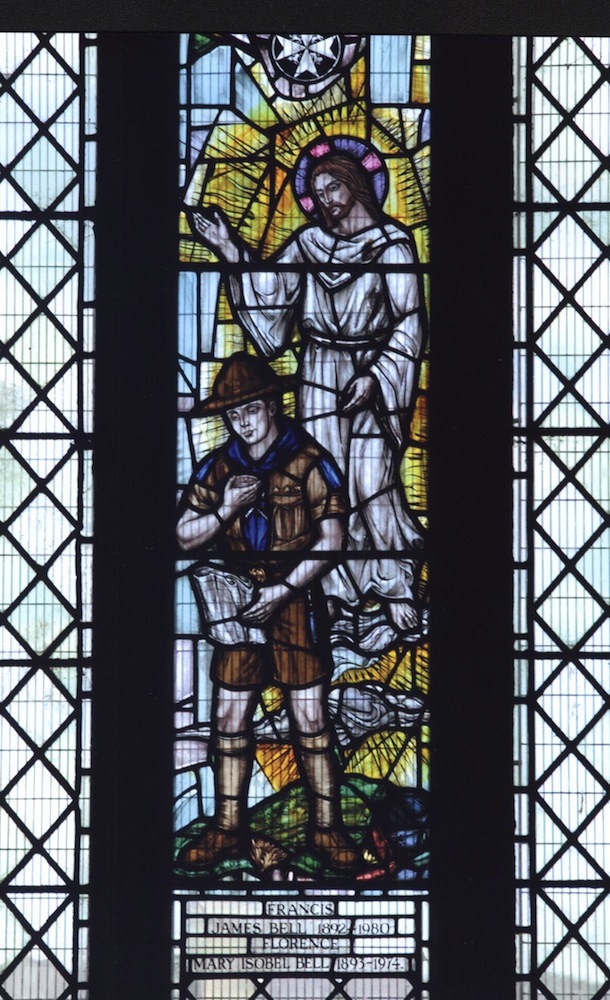The two exterior photographs here are by [offsite links] Eric Jones. They come, with many thanks, from a fine sequence originally posted on the geograph website, and have been licensed for reuse on the Creative Commons Licence. The remaining photographs were kindly sent in by Dr J. Ken Roberts. The one of the Stanley Chapel interior comes from the church history and guidbook for which he has written the text. Many thanks for these too, and for the extra information that came with them; the pictures should not be reproduced without permission. [Click on the images below to enlarge them.]

St Cybi's Church is a Grade I listed building, a late medieval church founded long before that, reputedly by the important Welsh saint, St Cybi. It has the rare distinction of standing inside the walls of a Roman fort. Built of brown stone, it was restored by George Gilbert Scott, 1877-79. Its fan vaulting dates from this time. The Stanley Chapel here came later, and dates from 1896-97, but, according to the church's own site, was also to Scott's design. St Cybi's overlooks Holyhead's inner harbour on the Island of Anglesey in North Wales.


Left: The entrance to St Cybi's Church. Right: The Stanley Chapel. Source: Roberts 51.
This is an attractive as well as an historic church, with, despite its much longer history, many points of Victorian interest. Until 2003, there was a statue of St Cybi by Hamo Thornycroft on the exterior of the Stanley Chapel. Although this has since been lost, Thornycroft's beautiful Italian marble memorial to Stanley can still be seen inside the chapel, with angels protecting the effigy. The Hon. William Owen Stanley (1802-1884) was a patron of the church and a member of the illustrious Stanley family, who had been "M.P. for Anglesey, 1837-1847, for Chester, 1850-1857, and for the Anglesey Boroughs, 1857-1874. He was also interested in Celtic Archaeology and wrote many articles in Archaeologica Cambrensis" ("Bangor University Penrhos Manuscripts"). This ancient site could not have been a better location for his last resting place.
The chapel is important too for its Morris & Co. windows. One, on the east wall directly over the monument, is of special significance because of its "Tree of Life" design, without any figures (see Crampin), while the other windows in the chapel were created from designs by Sir Edward Burne-Jones and John Henry Dearle.

Digital reproduction of the whole of the damaged Morris window.
Elsewhere in the church there are two more Morris windows. These are in the north transept: a three-light one of Jesus with the Virgin Mary and St John, and a two-light one, which cannot be seen in situ, of the Good Shepherd and Charity. This one has an interesting history all of its own. Dr Roberts (see headnote), writes in correspondence with the present author:
The last Morris factory window was hidden behind the organ and no living person could recall it — our [magnificent eighteenth-century] Lady Eleanor Organ was installed across it in 1932. It was only visible for ten years! Two years ago we had the window removed from behind the organ. It was shattered and in many pieces. The fragments were pictured on a light box and using the computer I assembled the pieces like a jigsaw puzzle, filling in missing parts from similar windows on the internet.... The window is boxed up hoping for future restoration and display on a light box.
Compare Charity here with the figure by Burne-Jones in St Martin's Church, Brampton, Cumbria.

Frank Bell Memorial window.
Among the other stained glass windows here, designed by firms established in the Victorian period, is the fine chancel window by Charles Eamer Kempe, though perhaps many people's favourite will be one of the more recent windows, very much later but at least telling of institutions established in the Victorian period. In memory of Mr and Mrs Frank Bell, it was the work of Celtic Studios in 1982, and shows Jesus watching over a boy scout. In the top left-hand corner is the Maltese Cross. Frank Bell was a much-loved Vicar's Warden, Sunday School Superintendent, Scoutmaster (founder of the second cub scout movement in the UK) and St John's Ambulance Officer (hence the Maltese Cross), who died in 1980. Dr Roberts writes that as a young man Frank Bell was on speaking terms with Baden Powell himself, so he provided a real link with the past.
Related Material
- Stanley Memorial
- "Tree of Life" from Morris & Co.
- Chancel window by Kempe
- St Michael by J. H. Dearle
- Christ as Love, with the Virgin Mary and St John, to designs by Edward Burne-Jones
- St Dorothy, St Theresa and St Agnes, to designs by Edward Burne-Jones
- Musician angels flanking Dearle's St Michael
- The Pharmacist's Window, signed by John J. Jennings
Sources
"Bangor University Penrhos Manuscripts." Archifau Cymru/Archives Wales. Web 12 November 2014.
"Church of St. Cybi, Holyhead, Anglesey." Stained Glass in Wales / Gwydr Lliw yng Nghymru. Web. 28 October 2015.
Crampin, Martin. "Llewelyn, Siwan and the Tree of Life." Stained Glass from Welsh Churches. Web 12 November 2014.
History of the Church." Friends of St Cybi's. Web 12 November 2014. (This lovely website has a virtual tour of the church.)
Roberts, Dr. J. K. The History of St Cybi's Church. Holyhead: Anglesey County Council, 2008. Many more details about the church can be found in this book.
St Cybi's Church, Holyhead. British Listed Buildings. Web 12 November 2014.
Last modified 29 October 2015